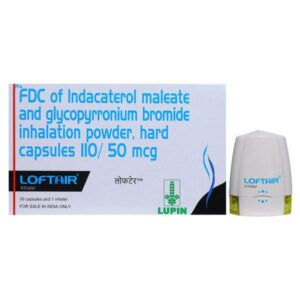GLYCOPYRRONIUM BROMIDE + INDACATEROL MALEATE
Glycopyrronium Bromide: Glycopyrronium bromide (also known as glycopyrrolate) is a medication used for the treatment of excessive sweating, medically known as hyperhidrosis. It is available in various forms, including tablets, solution for injection, and a topical gel.
The primary mechanism of action of glycopyrronium bromide is its ability to inhibit the action of acetylcholine, a chemical messenger in the body. Acetylcholine stimulates the sweat glands, and by blocking its activity, glycopyrronium reduces the amount of sweat produced.
For the treatment of hyperhidrosis, the recommended oral dose of glycopyrronium bromide is typically 1 to 2 mg once daily, although your doctor may adjust the dosage based on your individual needs. It is important to follow the specific instructions provided by your healthcare professional.
As with any medication, glycopyrronium bromide can cause side effects. Common side effects may include dry mouth, constipation, blurred vision, and urinary retention. These effects occur due to the anticholinergic action of the drug, which can reduce saliva production, slow bowel movements, affect visual accommodation, and reduce bladder muscle contractions.
It is important to note that due to its systemic nature, glycopyrronium bromide can also lead to other side effects such as dizziness, headache, dry eyes, dry skin, and nasal congestion. Additionally, some individuals may experience an allergic reaction to the medication, which can manifest as a rash, swelling, or difficulty breathing. If you experience any severe or persistent side effects, it is crucial to seek medical attention promptly.
Before using glycopyrronium bromide, it is essential to inform your healthcare professional about any other medications you are taking, as interactions may occur. Also, notify your doctor if you have any underlying medical conditions, such as glaucoma, gastrointestinal disorders, or urinary obstruction, as these may affect the suitability and dosage of the medication.
This description provides a general overview of glycopyrronium bromide. However, it is crucial to consult with a healthcare professional for detailed information and guidance regarding its use, dose, and potential side effects.
Indacaterol Maleate: Indacaterol Maleate is a long-acting beta2-adrenergic agonist (LABA) medication that is primarily used to control and prevent symptoms of chronic obstructive pulmonary disease (COPD) in adults. It belongs to a class of drugs known as bronchodilators, which work by relaxing the muscles in the airways, allowing for easier breathing.
The drug comes in the form of an inhalation powder, which is usually taken once daily using a special inhaler device. It is important to follow the dosing instructions provided by the healthcare professional or as indicated on the prescription label.
The recommended dose of Indacaterol Maleate for adults with COPD is 75 mcg once daily. However, the dosage may be adjusted based on individual patient response and the severity of the condition. It is not recommended for children or to treat asthma.
Some common side effects of Indacaterol Maleate include headache, cough, sore throat, runny or stuffy nose, nausea, dizziness, and muscle pain. If any of these side effects worsen or persist, it is important to inform a healthcare provider. Rare but serious side effects may include an increase in blood pressure, chest pain, heart palpitations, and worsening breathing problems.
It is important to note that Indacaterol Maleate is not a rescue medication for sudden breathing problems. If experiencing acute symptoms, a quick-acting inhaler should be used. Indacaterol Maleate should be used regularly as prescribed to control symptoms and improve lung function.
As always, it is essential to consult a healthcare provider or pharmacist for detailed instructions and to discuss potential drug interactions or contraindications before starting Indacaterol Maleate.

